Here are the foods with the highest amount of protein in them. When you’re trying to meet your protein needs it’s good to know which foods will help you along the most. As predicted there are many animal-based foods high in protein, so you’ll want to see our list of vegetarian or vegan sources of protein as alternatives if you’re trying to cut down on meat.
The average daily value of protein is set at 50 grams, but you’ll want to use an online protein calculator to come up with a more specific, personalized value based on your age, gender, and intended activity level.
[hr]
[column size=”one-third”] [/column]
[/column]
[column size=”two-third” last=”true”]
1. Chicken Breast: 30g Protein (60% DV)
Chicken breast tops the list, consisting of 30% protein and giving you more than half of your DV of protein in a 100 gram serving. It’s no wonder why this is a favorite of bodybuilders as well as those looking to add lean muscle to their physique.
Chicken breast is considered a high quality protein, and when compared to other cuts from the same chicken such as the leg or thigh, the breast contains more protein and less fat. So not only will chicken breast help you build lean muscle, it will help you lose fat as well, which is why it is found on many diet programs as a recommended food.
Chicken breast is also a good source of minerals like magnesium and iron, as well as B Vitamins 6 and 12. Chicken breast also contains cholesterol, so you’ll want to watch your intake as to not exceed your cholesterol for the day.
Tips for eating more: Chicken breast is one of the most popular main dishes in America, so it isn’t too hard to find a chicken breast recipe. Several recipes on our list of healthy chicken Crock Pot recipes use chicken breast, providing you with dozens of easy ways to eat more of it.[/column]
[hr]
[column size=”one-third”]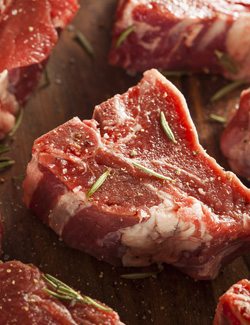 [/column]
[/column]
[column size=”two-third” last=”true”]
2. Pork Chop: 27g Protein (54% DV)
Pork chops secure the number two spot for protein rich foods, rivaling chicken breast for the amount of protein they contain.
Pork often takes a backseat to chicken and beef when it comes to popular meat choices, but lean cuts of pork offer plenty of protein without a lot of fat. It’s the fattier versions of pork like bacon and ham that have given it the reputation of being a fatty meat. But just as there are fattier pieces of beef and chicken, you can be selective with your pork and use it as a regular protein source.
Like any meat you’ll want to make sure that you are having a serving of vegetables with it to help your digestive system process it. Animal sources of protein contain no fiber of their own and need an assist in the way of a vegetable.
Tips for eating more: As long as you go with boneless pork chops you’ll be getting similar numbers to chicken breast, and pork chops can be cooked up very similarly to chicken breast, providing your meal with the protein needed to make it complete.[/column]
[hr]
[column size=”one-third”]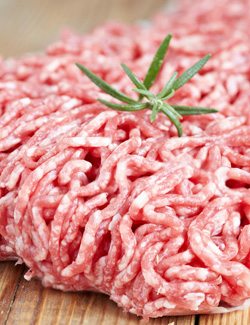 [/column]
[/column]
[column size=”two-third” last=”true”]
3. Ground Beef: 26g Protein (52% DV)
Ground beef is a protein-packed food that can get you halfway to your requirement in a hurry. It’s also very versatile, and tends to take on seasonings and spices well, making it a favorite go-to in many cuisines.
Beef in general is also a good source of iron, as well as B Vitamins, but it’s also high in cholesterol, so it’s important to consider all factors when it comes to meeting your various requirements and staying below your daily limits in other areas.
Always choose organic grass-fed ground beef to avoid the corn-fed conventional ground beef found in most stores. You’ll have to seek it out, as the majority of beef on offer at the grocery store is conventional, but with a little searching, or perhaps even asking an employee, you can find it.
Tips for eating more: Use lean ground beef in a wide assortment of recipes. Everything from Taco Night to chili and casseroles can be made with ground beef. Ninety percent lean ground beef will be much less oily than fattier cuts, creating lighter tasting dishes with all of the flavor.[/column]
[hr]
[column size=”one-third”]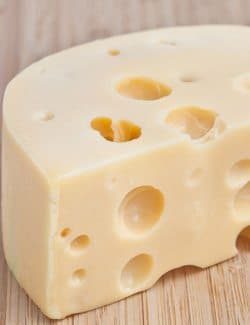 [/column]
[/column]
[column size=”two-third” last=”true”]
4. Swiss Cheese: 25g Protein (50% DV)
Swiss cheese is a protein powerhouse, but you probably won’t want to eat a 100g serving in order to meet half of your protein needs. That would be a lot of cheese in one sitting, and you have to factor in the other qualities of cheese when thinking of your protein needs.
Swiss cheese and other cheese are also a good source of calcium, so you’re not only helping to meet your protein requirements, you’re getting a good amount of calcium. Just one ounce of Swiss cheese gives you a fifth of the calcium you need for the day.
Many cheeses in addition to Swiss cheese are high in protein. Consider mozzarella, which at 22g protein from the same 100g serving is no slouch in the protein department. Just be aware of the fat and cholesterol content of whichever cheese you go with and balance the pros and cons of using it to meet your protein needs.
Tips for eating more: Cheese helps improve the taste of many foods and is often added to the top of chili, Mexican dishes, and more to give them their distinct flavor. Make a Protein Pizza with lean meats found on this list as well as protein-packed vegetables for the toppings, and shredded mozzarella used for the cheese.[/column]
[hr]
[column size=”one-third”] [/column]
[/column]
[column size=”two-third” last=”true”]
5. Lamb Loin: 25g Protein (50% DV)
Lamb makes it onto the top 5, and provides you with half of the protein you need for the day with a 100 gram serving. It’s easy to see how you could make up the other 50% with other foods throughout the day, and of course each person’s protein needs are a little different.
When you eat lamb you’ll also be topping up your iron reserves. Your body will make quick use of the iron from lamb, so you avoid the problems of iron absorption often found with iron supplementation.
Lamb is often thought of as a fatty meat, and isn’t the most popular meat in America, ranking higher in popularity in other countries like France, Australia, or Britain.
Tips for eating more: Lamb can be used much like beef in most recipes, but there are also plenty of delicious ways to cook lamb. Lamb chops or rack of lamb are two examples, and there are several Indian dishes that use lamb and complement it with an amazing array of spices and seasonings.[/column]
[hr]
[column size=”one-third”]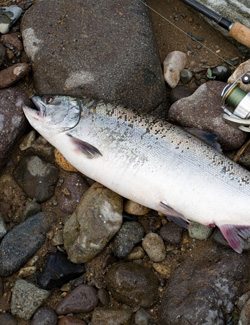 [/column]
[/column]
[column size=”two-third” last=”true”]
6. Salmon: 24g Protein (48% DV)
Salmon is often regarded as a healthy food you should be eating a few times a week, not only for its protein content but also because of the omega-3s it contains. If you’re looking for protein and a change from chicken and beef, fish makes an excellent choice. Go with oily fish to get the omega-3s as well.
The omega-3s you’re getting can be considered more important than the protein salmon contains, because there are several ways to get protein and fewer ways to meet your omega-3 needs.
Salmon benefits both the heart and the brain, the two most important organs you have, and both of these benefits are attributed to the omega 3’s it contains.
Tips for eating more: A fillet of salmon makes a great main dish, but don’t be afraid to branch out and try using salmon in different ways. You can make salmon cakes or salmon patties, or use it as an appetizer.[/column]
[hr]
[column size=”one-third”] [/column]
[/column]
[column size=”two-third” last=”true”]
7. Ham: 23g Protein (46% DV)
Ham makes the top ten in our list of foods high in protein, and it’s made up of almost a quarter protein. The mineral content of ham is also pretty impressive, providing generous amounts of thiamine and niacin, as well as riboflavin.
These minerals may not seem entirely important, as they don’t get as much attention as iron and magnesium, but they’re still important if you are looking to improve your overall health.
Ham contains more fat than some of the other sources of protein listed here, so it may not be the best way to get your protein if you’re trying to lose weight.
Tips for eating more: You don’t want to overdo it when it comes to eating ham, as it’s not the leanest cut of meat in general. Besides being eaten all by itself at a holiday dinner or making it onto a sandwich, you can add ham to soups, cube it and add it to a salad, or serve it up as part of a protein-filled breakfast.[/column]
[hr]
[column size=”one-third”]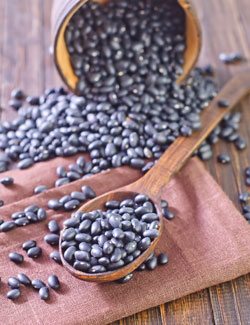 [/column]
[/column]
[column size=”two-third” last=”true”]
8. Black Beans: 22g Protein (44% DV)
The first non-meat item of our protein foods list is black beans, which pack a whopping 22 grams of protein into a 100 gram serving.
It’s not only black beans that rank highly in protein, many other beans have respectable protein numbers, such as navy beans, soybeans, lima beans, kidney beans, and more.
Black beans and other beans are also fantastic sources of soluble fiber, which will help you feel full, and balance your blood sugar. It’s nice that you can get both a protein portion and a fiber portion from the same food, as many high-protein items are devoid of fiber.
Tips for eating more: Black beans as well as other types of beans make a great side dish for a grilled chicken breast or steak. They also factor into many Mexican-themed dishes. Add them to soups and chilis for more texture, flavor, and protein.[/column]
[hr]
[column size=”one-third”] [/column]
[/column]
[column size=”two-third” last=”true”]
9. Almonds: 21g Protein (42% DV)
Almond and other nuts can provide you with decent amounts of protein. They’ll also help keep you satisfied because they provide both protein, fiber, and healthy fats, three factors in helping you have a sustained satisfied feeling.
Almonds are relatively high in calories, so the general rule is to keep your total daily consumption of almonds to a handful to avoid gaining weight.
One of the most important things that almonds contain is healthy fats, both monounsaturated and polyunsaturated. These fats will actually help you lose fat if needed, and will help maintain a healthy weight.
Tips for eating more: A handful of almonds makes a great snack that can help you make it to your next meal, while also helping to contribute to your total protein number. Slivered almonds go great on top of salads or other veggies like green beans. Crushed almonds can be added to your cooking in various ways for a nutty flavor and plenty of protein.[/column]
[hr]
[column size=”one-third”]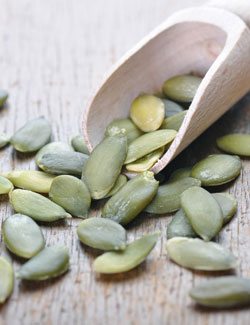 [/column]
[/column]
[column size=”two-third” last=”true”]
10. Pumpkin Seeds: 19g Protein (38% DV)
Pumpkin seeds have been gaining in notoriety for their healthiness, and being one of the high protein foods is part of that equation. The minerals in pumpkin seeds is what is getting all of the attention, including high levels of magnesium and zinc to help out important functions like pumping your heart and maintaining a good mood.
For men, keeping your zinc level up is a good step towards avoiding prostate cancer. For both sexes, pumpkin seeds can help you sleep due to the tryptophan it contains, a natural amino acid that helps produce more melatonin, the hormone that signals you that it’s time for sleep.
Not only pumpkin seeds, but sunflower seeds and flax seeds also offer a good amount of protein, so you can vary up your seed of choice to keep things interesting, but still get the protein you’re after.
Tips for eating more: Pumpkin seeds are a handy food that can go with you wherever you are for a timely snack.[/column]
[hr]
[column size=”one-third”] [/column]
[/column]
[column size=”two-third” last=”true”]
11. Eggs: 13g Protein (26% DV)
Eggs are a great way to boost your protein, and can be cooked up and eaten by themselves, or used as part of a larger dish. No matter how you get them, eggs will provide you with an assortment of vitamins and minerals.
The great debate over whether to eat the yolk or not is settled when it comes to getting more protein. You’ll want to eat both the yolk and the white to get all of the protein you can from the egg, as each contains similar amounts of protein. The reason the debate exists is due to the fat that’s in the yolk, and whether it’s worth eating the fat to get the protein and other benefits of eggs.
You can’t get the lion’s share of vitamins and minerals without eating the yolk, so while it’s good to keep an eye on your egg intake, you’ll want to eat the entire thing for the most protein and nutrients. Those looking to lose weight while at the same time building muscle may want to go with egg whites, but then switch to whole eggs once their goal weight is achieved.
Tips for eating more: Eggs can be made in several different ways depending on what you’re in the mood for. Hard-boiled eggs are perhaps the most portable, while classic standbys like scrambled and over easy make it easy to keep things interesting.[/column]
[hr]
[column size=”one-third”]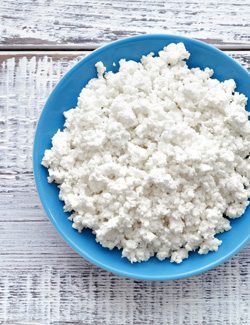 [/column]
[/column]
[column size=”two-third” last=”true”]
12. Cottage Cheese: 11g Protein (22% DV)
Cottage cheese has been noted for its protein content by several diet programs that are big on strength training. It’s a good way to start your day, as even a half cup of cottage cheese will provide you a double-digit percentage of your total protein needs for the day.
There’s plenty of calcium as well as Vitamin B-12 in cottage cheese, so you’re getting multiple benefits from it, not just a relatively high protein content.
If you go with a low fat or a nonfat version of cottage cheese you’ll be getting plenty of protein with fewer calories and total fat grams. Full fat cottage cheese may get you into trouble because of its saturated fat content. The low fat and nonfat varieties help you avoid this concern.
Tips for eating more: Try using cottage cheese as a healthier replacement than ricotta cheese. You can use it in Italian pasta dishes for a cheesy flavor and plenty of protein, with less fat and calories.[/column]
[hr]
[column size=”one-third”] [/column]
[/column]
[column size=”two-third” last=”true”]
13. Greek Yogurt: 10g Protein (20% DV)
Greek yogurt has become famous in recent years thanks to its higher protein content when compared to ordinary yogurt. The protein helps keep you feeling satisfied, and also makes for a better choice for those looking to build lean muscle, while still losing fat.
Greek yogurt has a thicker consistency than regular yogurt, as the whey has been removed through a straining process, which is why it is also referred to as strained yogurt. For protein aficionados the protein in Greek yogurt is casein protein rather than whey protein as the whey has been strained out.
Like regular yogurt, Greek yogurt is a good source of probiotic bacteria. Just be sure to go with a Greek yogurt that isn’t loaded up with sugar in order to get the full benefits.
Tips for eating more: Greek yogurt can be eaten in much the same way that you’ve eaten regular yogurt in the past. Pack it as a snack for the day, or eat it at breakfast time along with fresh fruit. It also makes a smart substitute for sour cream.[/column]
[hr]
[column size=”one-third”] [/column]
[/column]
[column size=”two-third” last=”true”]
14. Oysters: 9g Protein (18% DV)
Oysters may not be on the regular menu, but they are a good source of protein as well as important vitamins and minerals the body needs each day.
They’re packed with Vitamin B-12, which will provide you with plenty of energy, help with your cholesterol levels, and can help protect you from certain cancers. You don’t have to eat a heaping serving of oysters to get a full day’s supply of Vitamin B-12, three medium-sized oysters will give you 100% of your Daily Value of B-12, not to mention 4 grams of protein.
Oysters are also known as an aphrodisiac, and science has actually found a possible connection based on a specific amino acid they contain that is linked to sex hormones in the body.
Tips for eating more: Oysters work well in a seafood chowder, especially if their texture when raw is a bit off-putting. You may also want to try an oyster dish where the oysters are cooked if you don’t like them raw.[/column]
[hr]
[column size=”one-third”] [/column]
[/column]
[column size=”two-third” last=”true”]
15. Tofu: 8g Protein (16% DV)
Tofu is derived from soybeans and is often used as a meat substitute for those looking to reduce the amount of meat they eat, as well as those following a meatless diet plan.
If you’re trying to build muscle by eating more protein, you can supplement your meat intake with tofu and still get the benefit of a quality protein source. You aren’t limited to just tofu when it comes to a soy-based food that provides protein. Try tempeh as a high-protein food that can also sub in for meat.
Tofu is also an excellent source of calcium, and the same 100 gram serving that nets you 16% of your protein for the day gets you 35% of your calcium.
Tips for eating more: Vegans and vegetarians have been using tofu for years to replace meat, thanks to its various textures and high protein levels. If you’ve been looking to reduce your meat intake, tofu can help. Try subbing in tofu for the meat in your favorite dishes. Choose between silken tofu or one of the firmer varieties depending on the recipe you’re using.[/column]
[hr]
You may also like our recipes for homemade protein bars and shakes.




